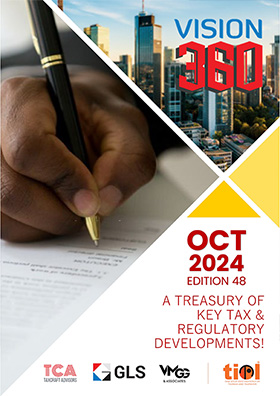CX - It is 'nature of order' of Tribunal and not 'scope of appeal' that determines maintainability: HC
By TIOL News Service
CHANDIGARH, MAR 24, 2017: THE facts:
i. M/s SBM Woolen Mills is a partnership firm consisting of two partners, one Satnam Singh and his brother one Mohinder Singh. It manufactures grey acrylic spun yarn.
ii. The respondent, Raja Dyeing is a partnership firm whose partners are one Bhupinder Singh and the wife of Satnam Singh. It manufactures dyed acrylic yarn.
iii. Rosy Woolen Mills (RWM) sells the dyed yarn purchased by it, inter alia , from the respondent.
iv. The case of the Revenue is that SBM evaded duty by under-valuing the goods namely grey acrylic yarn by clearing them to the respondent RD and RWM at prices far less than even the cost of production.
v. The respondent availed exemption under Notification No. 5/99-CE and 6/2000-CE which prescribes a concessional rate of duty for the dyed acrylic spun yarn subject to the condition that the same had been manufactured out of the goods on which the appropriate duty of excise, under the schedule thereto had been paid and no credit had been taken.
vi. Having come to the conclusion that the goods were purchased by the respondent from SBM at an under valuation, the Commissioner inferred that SBM had not paid the appropriate duty of excise and accordingly held that even the respondent was not entitled to the benefit of the said notification(s).
vii. The Department also alleged that the goods sold in cash to persons other than the respondent had actually been cleared to the respondent who used the same for the manufacture of unaccounted goods and the same had been cleared clandestinely without payment of duty.
viii. The Commissioner confirmed the duty of Rs.15,14,161/- against the respondent on account of the respondent having wrongly availed the exemption under the said notification and also confirmed the demand of Rs.36,78,122/- towards duty on account of clandestine removal together with interest thereon and penalty in respect thereof.
Revenue is in appeal against the CESTAT order setting aside the duty demand of Rs.36,78,122/- as being unsustainable.
The Respondent assesseeraised a preliminary objection as to the maintainability of the appeal u/s 35G of the Act. It is contended that the appeal is not maintainable as the order passed by the Appellate Tribunal relates among other things to the determination of questions having a relation to the rate of duty of excise and/or to the value of goods for the purposes of assessment.
The counsel for the Revenue challenges the aforesaid plea by submittingthat the appeal only raises the issue of clandestine removal of goods and this issue is not related either to the rate of duty of excise or to the value of goods for the purposes of assessment.
Extracting the provisions of section 35G and 35L of the CEA, 1944, the High Court in an elaborate order observed –
+ Even as regards the respondent alone, the Tribunal by the impugned order decided questions that fall within the ambit of Section 35 G as well as with questions that fall outside the ambit of Section 35 G and within the ambit of Section 35L of the Act.
+ While deciding the maintainability of the appeal, the merits are not relevant. It is necessary only to note the questions that were determined by the Appellate Tribunal.
+ An appeal under Section 35 G is against the order passed in appeal by the Appellate Tribunal and not against the order of the Adjudicating Authority. An appeal does not lie to this Court from the order of the adjudicating authority/Commissioner. The issue as to whether an appeal is maintainable or not must, therefore, be decided on the basis of and taking into consideration the order passed in appeal by the appellate authority and not by the order passed by the adjudicating authority.
+ In any event, the order of the adjudicating authority would stand merged in the order of the appellate authority. In other words, while determining whether an appeal is maintainable under Section 35G or not, it is necessary to see whether, the order passed in appeal by the Appellate Tribunal and not the order passed by the adjudicating authority, determines any question having any relation to the rate of duty of excise or to the value of goods for purposes of assessment.
+ The words “among other things” in Section 35G are of singular importance in determining the ambit of Section 35G. These words indicate that an appeal is maintainable under Section 35G to the High Court only if the order passed in appeal by the Tribunal is not one relating to the determination of any question having a relation to the rate of duty of excise or to the value of goods for the purposes of assessment, an appeal against that order would lie only to the Supreme Court under Section 35 L and not to the High Court under Section 35 G. This would be so even if the appealis only in respect of questions other than the rate of duty or the value of the goods for the purpose of assessment. It is the nature of the order of the Tribunal and not the scope of the appeal that determines the maintainability of the appeal under Section 35G.
+ The intention is to consolidate all appeals from the order of the Tribunal in one Court - either in the High Court or in the Supreme Court.
+ Whether an appeal lies to the High Court under Section 35G or to the Supreme Court under Section 35L cannot possibly depend upon the nature or scope of the appeal that the party intends filing. A party may seek to challenge only that part of the order of the Tribunal which relates to questions other than those relating to the rate of duty of excise or the value of the goods for the purposes of assessment. Such an appeal would, absent any other questions, lie to the High Court.
+ Once it is held that an appeal against the order of the Tribunal which deals with questions that fall within the ambit of Section 35L as well as other questions lies to the Supreme Court under Section 35L the mere fact that the party chooses to challenge only that part of the order that falls within the ambit of Section 32 G would make no difference .
+ In other words, it cannot be said that the party that chooses to challenge the order of the Tribunal only so far as it relates to the determination of questions falling within the ambit of 35G must file the appeal before the High Court even though the order also deals with questions that fall within the ambit of Section 35L.
+ It can hardly be suggested that in that case, the appeal filed under Section 35 G before the High Court ought to stand transferred to the Supreme Court. The scheme of the Act in general and Sections 35 G and 35 L in particular do not indicate such a mechanism.
Drawing support from the decisions in - Scott Wilson Kirkpatrick (I) Pvt. Ltd. = 2011-TIOL-976-HC-KAR-ST , BhartiAirtel Ltd. = 2013-TIOL-596-HC-DEL-ST , Ernst & Young Pvt. Ltd. = 2014-TIOL-263-HC-DEL-ST & Vimla Rolling Mills = 2014-TIOL-1580-HC-DEL-CX the High Court, nonetheless, expressed a reservation regarding the observation made in the referred orders that the issues and contentions decided in the order-in-original would determine whether an appeal would lie in the High Court under Section 35 G or in the Supreme Court under Section 35 L.
The High Court further observed that in it's view it is not the order-in-original i.e. the order of the adjudicating authority but the order of the Tribunal that would determine the issue as to whether the appeal lies to the High Court under Section 35 G or to the Supreme Court under Section 35 L .
The High Court explained thus - Section 35 G provides for an appeal to the High Court from every order passed in appeal by the appellate Tribunal. It is, therefore, the order of the Appellate Tribunal that must determine the issue. Moreover Section 35 G restricts the ambit of the appeal to orders of the Tribunal “not being an order relating, among other things, to the determination….”. The words “an order” relate to the order passed in appeal by the Appellate Tribunal.
After distinguishing the case laws cited by the counsel, the High Court dismissed the Revenue appeal on the ground that it was not maintainable u/s 35G of the CEA, 1944.
(See 2017-TIOL-552-HC-P&H-CX)















